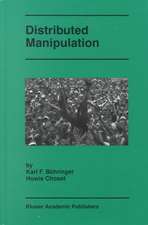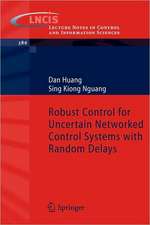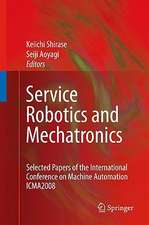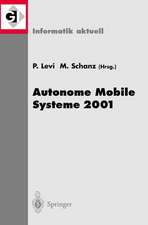Mobile Robot Navigation with Intelligent Infrared Image Interpretation
Autor William L. Fehlman, Mark K. Hindersen Limba Engleză Hardback – 4 mar 2010
| Toate formatele și edițiile | Preț | Express |
|---|---|---|
| Paperback (1) | 944.99 lei 43-57 zile | |
| SPRINGER LONDON – 28 noi 2014 | 944.99 lei 43-57 zile | |
| Hardback (1) | 948.92 lei 43-57 zile | |
| SPRINGER LONDON – 4 mar 2010 | 948.92 lei 43-57 zile |
Preț: 948.92 lei
Preț vechi: 1157.22 lei
-18% Nou
Puncte Express: 1423
Preț estimativ în valută:
181.57€ • 190.09$ • 150.24£
181.57€ • 190.09$ • 150.24£
Carte tipărită la comandă
Livrare economică 07-21 aprilie
Preluare comenzi: 021 569.72.76
Specificații
ISBN-13: 9781848825086
ISBN-10: 1848825080
Pagini: 216
Ilustrații: XXIX, 274 p.
Dimensiuni: 155 x 235 x 23 mm
Greutate: 0.54 kg
Ediția:2010
Editura: SPRINGER LONDON
Colecția Springer
Locul publicării:London, United Kingdom
ISBN-10: 1848825080
Pagini: 216
Ilustrații: XXIX, 274 p.
Dimensiuni: 155 x 235 x 23 mm
Greutate: 0.54 kg
Ediția:2010
Editura: SPRINGER LONDON
Colecția Springer
Locul publicării:London, United Kingdom
Public țintă
ResearchDescriere
Mobile robots require the ability to make decisions such as "go through the hedges" or "go around the brick wall." Mobile Robot Navigation with Intelligent Infrared Image Interpretation describes in detail an alternative to GPS navigation: a physics-based adaptive Bayesian pattern classification model that uses a passive thermal infrared imaging system to automatically characterize non-heat generating objects in unstructured outdoor environments for mobile robots. The resulting classification model complements an autonomous robot’s situational awareness by providing the ability to classify smaller structures commonly found in the immediate operational environment.
The approach described in this book is an application of Bayesian statistical pattern classification where learning involves labeled classes of data (supervised classification), assumes no formal structure regarding the density of the data in the classes (nonparametric density estimation), and makes direct use of prior knowledge regarding an object class’s existence in a robot’s immediate area of operation when making decisions regarding class assignments for unknown objects. The result is a novel classification model which not only displays exceptional performance in characterizing non-heat generating outdoor objects in thermal scenes, but also outperforms the traditional KNN and Parzen classifiers.
Mobile Robot Navigation with Intelligent Infrared Image Interpretation will be of interest to researchers and developers of advanced mobile robots in academic, industrial and military sectors. Advanced undergraduates studying robot sensor interpretation, pattern classification or infrared physics will also appreciate this book.
The approach described in this book is an application of Bayesian statistical pattern classification where learning involves labeled classes of data (supervised classification), assumes no formal structure regarding the density of the data in the classes (nonparametric density estimation), and makes direct use of prior knowledge regarding an object class’s existence in a robot’s immediate area of operation when making decisions regarding class assignments for unknown objects. The result is a novel classification model which not only displays exceptional performance in characterizing non-heat generating outdoor objects in thermal scenes, but also outperforms the traditional KNN and Parzen classifiers.
Mobile Robot Navigation with Intelligent Infrared Image Interpretation will be of interest to researchers and developers of advanced mobile robots in academic, industrial and military sectors. Advanced undergraduates studying robot sensor interpretation, pattern classification or infrared physics will also appreciate this book.
Cuprins
Data Acquisition.- Thermal Feature Generation.- Thermal Feature Selection.- Adaptive Bayesian Classification Model. Conclusions and Future Research Directions.
Notă biografică
William L. Fehlman II is a lieutenant colonel in the United States Army. He received a BS in Mathematics from SUNY Fredonia in 1990 and MS in Applied Mathematics from Rensselaer Polytechnic Institute in 2000. He earned a PhD in Applied Science from The College of William and Mary in 2008, and is currently assigned as an Assistant Professor of Mathematics at the United States Military Academy, West Point, New York. His research interests include pattern classification, multi-sensor data fusion, and autonomous robotic systems.
Mark K. Hinders holds a BS, MS and PhD in Aerospace and Mechanical Engineering from Boston University, and is currently Professor of Applied Science at the College of William and Mary in Virginia. Before coming to Williamsburg in 1993, Professor Hinders was Senior Scientist at Massachusetts Technological Laboratory, Inc., and also Research Assistant Professor at Boston University. Before that Dr Hinders was an Electromagnetics Research Engineer at the USAF Rome Laboratory located at Hanscom AFB, MA. Professor Hinders conducts research in wave propagation and scattering phenomena, applied to medical imaging, intelligent robotics, security screening, remote sensing and nondestructive evaluation. He and his students study the interaction of acoustic, ultrasonic, elastic, thermal, electromagnetic and optical waves with materials, tissues and structures.
Mark K. Hinders holds a BS, MS and PhD in Aerospace and Mechanical Engineering from Boston University, and is currently Professor of Applied Science at the College of William and Mary in Virginia. Before coming to Williamsburg in 1993, Professor Hinders was Senior Scientist at Massachusetts Technological Laboratory, Inc., and also Research Assistant Professor at Boston University. Before that Dr Hinders was an Electromagnetics Research Engineer at the USAF Rome Laboratory located at Hanscom AFB, MA. Professor Hinders conducts research in wave propagation and scattering phenomena, applied to medical imaging, intelligent robotics, security screening, remote sensing and nondestructive evaluation. He and his students study the interaction of acoustic, ultrasonic, elastic, thermal, electromagnetic and optical waves with materials, tissues and structures.
Textul de pe ultima copertă
Mobile robots require the ability to make decisions such as "go through the hedges" or "go around the brick wall." Mobile Robot Navigation with Intelligent Infrared Image Interpretation describes in detail an alternative to GPS navigation: a physics-based adaptive Bayesian pattern classification model that uses a passive thermal infrared imaging system to automatically characterize non-heat generating objects in unstructured outdoor environments for mobile robots. The resulting classification model complements an autonomous robot’s situational awareness by providing the ability to classify smaller structures commonly found in the immediate operational environment.
The approach described in this book is an application of Bayesian statistical pattern classification where learning involves labeled classes of data (supervised classification), assumes no formal structure regarding the density of the data in the classes (nonparametric density estimation), and makes direct use of prior knowledge regarding an object class’s existence in a robot’s immediate area of operation when making decisions regarding class assignments for unknown objects. The result is a novel classification model which not only displays exceptional performance in characterizing non-heat generating outdoor objects in thermal scenes, but also outperforms the traditional KNN and Parzen classifiers.
Mobile Robot Navigation with Intelligent Infrared Image Interpretation will be of interest to researchers and developers of advanced mobile robots in academic, industrial and military sectors. Advanced undergraduates studying robot sensor interpretation, pattern classification or infrared physics will also appreciate this book.
The approach described in this book is an application of Bayesian statistical pattern classification where learning involves labeled classes of data (supervised classification), assumes no formal structure regarding the density of the data in the classes (nonparametric density estimation), and makes direct use of prior knowledge regarding an object class’s existence in a robot’s immediate area of operation when making decisions regarding class assignments for unknown objects. The result is a novel classification model which not only displays exceptional performance in characterizing non-heat generating outdoor objects in thermal scenes, but also outperforms the traditional KNN and Parzen classifiers.
Mobile Robot Navigation with Intelligent Infrared Image Interpretation will be of interest to researchers and developers of advanced mobile robots in academic, industrial and military sectors. Advanced undergraduates studying robot sensor interpretation, pattern classification or infrared physics will also appreciate this book.
Caracteristici
Describes a model which will allow mobile robots to "see beyond vision" using infrared imaging: to autonomously assess the physical nature of surrounding structures for making decisions without the need for interpretation by humans
Includes supplementary material: sn.pub/extras
Includes supplementary material: sn.pub/extras

























